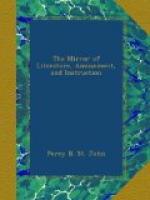he retired again to Kensington, where, according to
Lord Clarendon, he was visited by all the disaffected
members of parliament, who held frequent meetings
at Holland House. Some time afterwards, when
the civil war was at its height, he joined the king’s
party at Oxford; but, meeting with a cool reception,
returned again to the parliament. In August 6,
1647, “the members of the parliament who were
driven from Westminster by tumults, met General Fairfax
at Holland House, and subscribed to the declaration
of the army, and a further declaration, approving
of and joining with the army, in all their late proceedings,
making null all acts passed by the members since July
6.” (
Clarendon.)— The Earl
of Holland’s desertion of the royal cause, is
to be attributed, perhaps, to his known enmity towards
Lord Strafford; he gave, nevertheless, the best proof
of his attachment to monarchy, by making a bold, though
rash attempt, to restore his master. After a valiant
stand against an unequal force, near Kingston upon
Thames, he was obliged to quit the field, but was
soon after taken prisoner, and suffered death upon
the scaffold. His corpse was sent to Kensington,
and interred in the family vault there, March 10,
1649. In the July following, Lambert, then general
of the army, fixed his headquarters at Holland House.
It was soon afterwards restored to the Countess of
Holland. When theatres were shut up by the Puritans,
plays were acted privately at the houses of the nobility,
who made collections for the actors. Holland
House is particularly mentioned, as having been used
occasionally for this purpose.
The next remarkable circumstance in the history of
Holland House, is the residence of Addison, who became
possessed of it in 1716, by his marriage with Charlotte,
Countess Dowager of Warwick and Holland. It is
said that he did not add much to his happiness by
this alliance; for one of his biographers, rather
laconically observes, that “Holland House is
a large mansion, but it cannot contain Mr. Addison,
the Countess of Warwick, and one guest, Peace.”
Mr. Addison was appointed Secretary of State, in 1717,
and died at Holland House, June 17, 1719. Addison
had been tutor to the young earl, and anxiously, but
in vain, endeavoured to check the licentiousness of
his manners. As a last effort, he requested him
to come into his room when he lay at the point of
death, hoping that the solemnity of the scene might
work upon his feelings. When his pupil came to
receive his last commands, he told him that he had
sent for him to see how a Christian could die; to
which Tickell thus alludes:—
He taught us how to live; and oh! too
high
A price for knowledge, taught us how to
die!
On the death of this young nobleman, in 1721, unmarried,
his estates devolved to the father of Lord Kensington,
(maternally descended from Robert Rich, Earl of Warwick.)
who sold Holland House, about 1762, to the Right Hon.
Henry Fox, afterwards Lord Holland, the early years
of whose patriotic son, the late C.J. Fox, were
passed chiefly at this mansion; and his nephew, the
present Lord Holland, is now owner of the estate.




